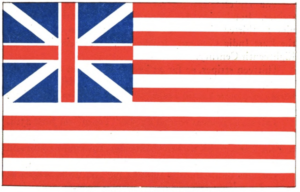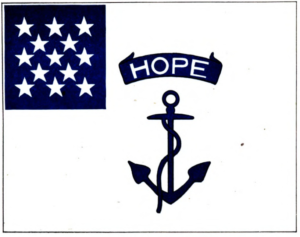Pre-Revolutionary Flags – Origin of the 13 Stripes
Researching the origin of the 13 stripes, the idea of stripes in the American flag originated from the British East India Company’s flag, which featured red and white stripes. The American colonists, who were heavily influenced by British culture and traditions, adopted a similar design for their own flag to symbolize their ties to Britain and their loyalty to the British Crown. However, as tensions between the colonies and Britain grew, the stripes on the American flag came to represent the 13 colonies themselves, and their fight for independence. The number of stripes was eventually reduced to 13 to symbolize the 13 independent states, and the stripes have since become an iconic symbol of the United States and its independence.
The first documented use of the 13 stripe flag was on June 23rd,1775, when it was flown as General Washington travelled from Philadelphia to New York. Then, at Cambridge, he assumed control of the Continental Army. The alternating stripes on this early version were blue and silver.

Early 13 Stripe Flags
There is some historical evidence that an early flag containing thirteen alternate red and white stripes was displayed on the ship Alfred on December 3rd, 1775. It was hoisted by you John Paul Jones, who was soon to be promoted to Senior Lieutenant of the ship and later went on to become one of the greatest naval commanders in American history and is remembered as a hero of the American Revolution. He is often referred to as the “Father of the American Navy.”
This flag, although it had the 13 red and white alternating stripes, still didn’t have the field of stars. Instead, it still had the British Union Jack consisting of the crosses of Saint George and Saint Andrew combined. It was known as the Grand Union Flag, or alternately the Continental Colors, the Congress Flag, or the Cambridge Flag
The Grand Union Flag
The Grand Union Flag was used by the Continental Army and the Continental Navy during the early stages of the American Revolution and served as a precursor to the more well-known Stars and Stripes flag. Despite its widespread use, the Grand Union Flag was never officially adopted as the national flag of the United States and was eventually replaced by the Stars and Stripes. Today, it is considered a historical American flag and is sometimes used to commemorate the early days of the American Revolution.
Yet, the Grand Union Flag was still in use well after the revolution started. It wasn’t until Flag Resolution of June 14, 1777, that the record stated, “Resolved: that the flag of the United States be made of thirteen stripes, alternate red and white; that the union be thirteen stars, white in a blue field, representing a new Constellation.”

13 Stars
The idea for the 13 stars may have come from the colonial banner of Rhode Island, or it may have been a derivative of the headquarters flag used by George Washington.
The field of stars on the US flag was inspired by the idea of a constellation and was meant to symbolize the newly independent states of the Union. The design of the first Stars and Stripes flag, which was created in 1777, featured 13 white stars on a blue field in the canton (upper left corner) to represent the 13 colonies that had declared independence from Britain.
As the number of states in the Union grew, the number of stars on the flag was updated to reflect this, with new stars added on July 4th of the year following the admission of each new state. The stars on the American flag have come to symbolize the unity and strength of the nation, and the blue field represents the states themselves. The stars and stripes together symbolize the independence, liberty, and democracy that the United States represents to its citizens and the world.